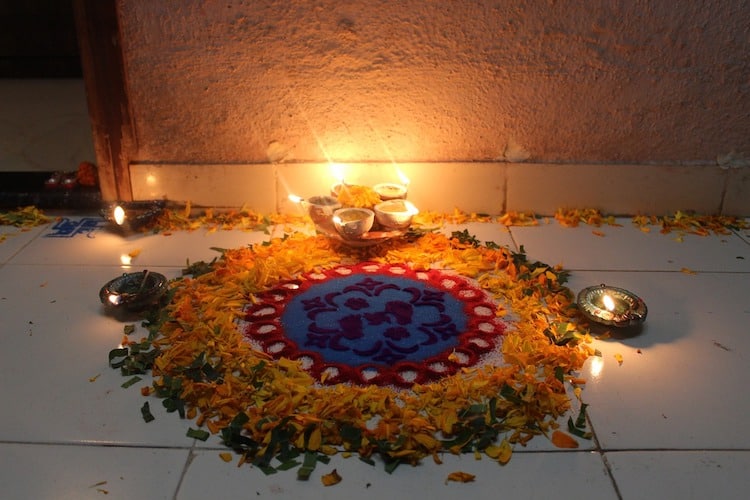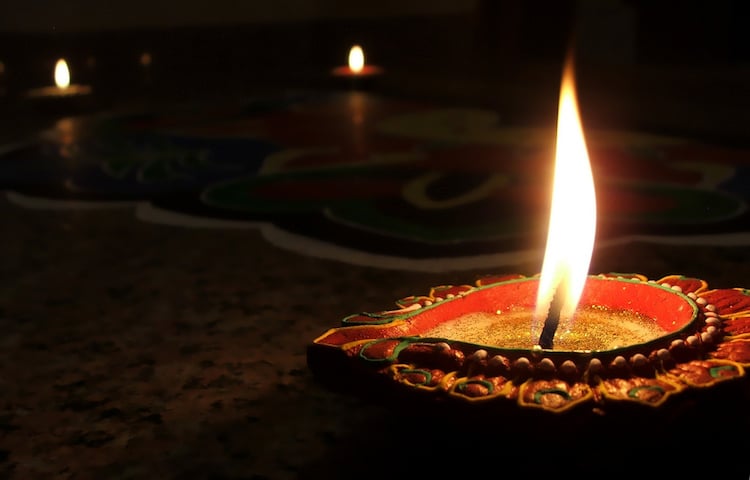Last updated on August 14th, 2023 at 09:55 pm
The season’s brightest and most spectacular festival by far, Diwali is the Hindu celebration of lights that dates back more than 2,500 years. This year, Diwali will take place in the first days of November. Celebrations begin on November 5th and continue through November 9th.
If you’ve always wondered about the history of Diwali, we’ve put together a brief history to share with you.
When is Diwali celebrated this year?
- Abhinaba Basu / Flickr
India’s festival of lights is held on the 15th day of the Hindu lunar month of Kartik. This means that the Diwali date varies a bit each year by the cycle of the moon, falling somewhere in October or November.
The main festival night of Diwali always occurs on the night of the new moon, also called the “darkest night.” Candles or lamps are lit to bid the presence of the various deities that communities across India recognize on this night. The lights also affirm the triumph of hope over despair, and good over evil.
In 2018, Diwali is celebrated on November 7. It is observed a day earlier in South India, on November 6.
The history of Diwali
The word Diwali comes from the Sanskrit word Deepavali, meaning “row of lights.” While rooted in Hinduism, Diwali is celebrated across many cultures and religions in India.
The festival most likely began as a harvest celebration, and is rooted in a number of stories from ancient religious texts. For a majority of Hindus, especially in northern and central India, Diwali marks the return home of deities Rama, Sita, Lakshmana, and Hanuman to Ayodhya after 14 years of exile. Celebrants of the holiday across India light oil lamps and candles to help guide Rama and his wife Sita home.
In southern India, Diwali popularly celebrates a story of the Hindu god Krishna—a different incarnation of Vishnu—in which Krishna frees 16,000 women from an evil king.
In the western state of Gujarat, one of India’s multiple New Year celebrations coincides with Diwali. Their Diwali celebration is associated with the goddess of prosperity, wealth, good luck, and happiness: Lakshmi. During the celebration, gifts and coins are often exchanged.
And in eastern India, local Hinduism often associates the Diwali festival with the goddess Durga, and her victory of good over evil.
How communities celebrate the Diwali story and interpret its meaning can depend on the region they live in as well as their religious affiliation. However, a strong common thread shines through each Diwali celebration regardless of location or faith: the triumph of light over darkness, and good over evil.
The five days of Diwali
- Kinshuk Kashyap / Flickr
While Diwali takes place on a single day, Diwali celebrations last at least five days. In preparation for Diwali, homes are cleaned, new clothes purchased, and sweets and gifts purchased for friends and family members.
In line with the spiritual importance of renewal and reflection for Diwali, many people also rise before sunrise during the festival days; work actively to forgive and release grudges; spend time with family; and, in the case of business owners, begin new account books and pray for prosperity in the coming year.
Day One of Diwali: Dhanteras
Celebrations for Diwali this year begin on November 5th with Dhanteras. Dhan means wealth, and teras refers to the 13th day of the lunar month of Kartik. It is believed that buying precious metals on this day brings good fortune. Many stores in India offer deals in celebration of Diwali. Card games, stock investments, and the blessing of account books are other popular ways to participate in this festival of wealth.
Day Two of Diwali: Naraka Chaturdasi (or Chhoti Diwali)
The second day of the Diwali celebration is Naraka Chaturdasi, or Chhoti Diwali (small Diwali). Paper demon effigies are burned in Goa, honoring the belief that Lord Krishna and Goddess Kali defeated the demon Narakasura on this day. This victory assured the release of the 16,000 princesses mentioned earlier. Since Diwali begins a day earlier in Goa and the south of India, this day is the main Diwali celebration in this region rather than new moon night as it is in the rest of the country. Pujas are performed with oils, flowers, and sandalwood to the goddess on this day.
Day Three of Diwali: Amavasya
The third, most important day of the Diwali celebration in most places is the new moon day, known as Amavasya. This darkest day of the month is the most important day of the festival throughout most of north and west India. Nighttime pujas are held to celebrate Lakshmi, although some regions focus on honoring the goddess Kali. This day—November 7, 2018—is when candles, oil lamps, and fireworks appear throughout homes and public places.
Day Four of Diwali: Govardhan Puja (or Bali Pratipada)
The fourth day of the festival—on November 8th this year—has different meanings across the different regions of India, and has several different names. In north India, Govardhan Puja is celebrated as the day when Lord Krishna defeated Indra, the god of thunder and rain. In many households, wives pray for the long life and prosperity of husbands, and husbands present wives with gifts. In several other regions, this day celebrates Lord Vishnu’s victory over demon king Bali on this day.
Day Five of Diwali: Bhai Duj
The fifth and final day of Diwali, known as Bhai Duj, is a day for celebrating siblings. The name duj means second day after the new moon, and bhai means brother. Sisters traditionally place a vermilion tilak, or mark, on their brothers’ foreheads on this post-Diwali celebration day, while brothers take time to lavish gifts on their sisters.

Diwali, the biggest and brightest holiday of India, is celebrated worldwide.
Send your loved ones the light of Diwali from afar with a special gift showing you care by sending money to India with Remitly. Shubh Deepavali!


